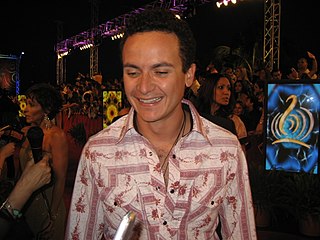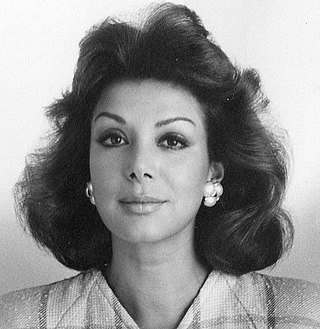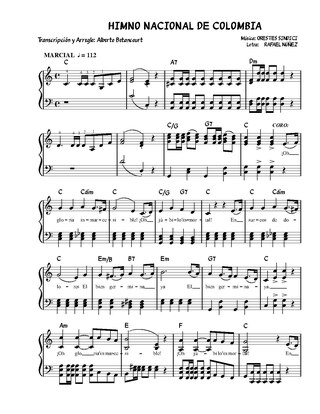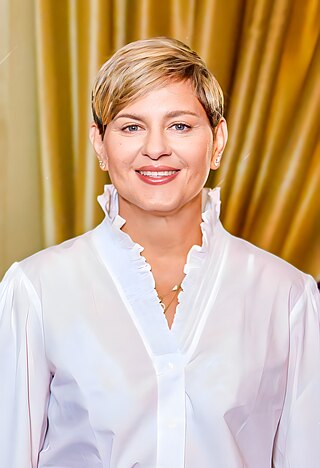Related Research Articles

Barranquilla is the capital district of the Atlántico department in Colombia. It is located near the Caribbean Sea and is the largest city and third port in the Caribbean coast region; as of 2018, it had a population of 1,206,319 making it Colombia's fourth-most populous city after Bogotá, Medellín, and Cali.

Gonzalo Arango Arias was a Colombian writer, poet, and journalist. In 1958 he led a modern literary and cultural movement known as Nadaism (Nothing-ism), inspired by surrealism, French existentialism, beat generation, dadaism, and influenced by the Colombian writer and philosopher Fernando González Ochoa.

Juan Fernando Fonseca Carrera is a Colombian singer. Born in Bogotá, he chose music at an early age, studying music formally at institutions such as Javeriana University in Bogota and Berklee College of Music in Boston. Fonseca's self-titled debut gained him considerable attention in Colombia. His second album released Corazón (2005) explored the crossroads where pop/rock influences meet vallenato, bullerengue, and tambora. Gratitud followed in 2008, with Ilusión arriving in 2011.

Iván René Valenciano Pérez is a Colombian former professional footballer who played as forward. He is the second top goalscorer of all-time in the Colombian Primera A with 217 goals, behind Argentine Sergio Galván Rey, who surpasses him with 224 goals.

María del Socorro Tellado López, known as Corín Tellado, was a prolific Spanish writer of romantic novels and photonovels that were best-sellers in several Spanish-language countries. She published more than 4,000 titles and sold more than 400 million books which have been translated into several languages. She was listed in the 1994 Guinness World Records as having sold the most books written in Spanish, and earlier in 1962 UNESCO declared her the most read Spanish writer after Miguel de Cervantes.

Álvaro José Arroyo González was a Colombian salsa and tropical music singer, composer and songwriter. He is considered one of the greatest performers of Caribbean and salsa music in his country and across Latin America. In 2018 Billboard counted Arroyo's song "La Rebelión" as one of the "15 Best Salsa Songs Ever".

Silvestre Dangond Vives Delano is a Colombian singer. He attributes his talents to his father, the singer William José "El Palomo" Dangond Baquero, who during the mid-1970s recorded 10 singles with Andrés "El Turco" Gil; and his mother, who comes from a musical family and passed down her charismatic nature to him, while also playing a major role in his formal and personal education.
The North Coast Cartel was a drug cartel operating in northern Colombia between in 1980 and 2010, mostly controlling the area of the Colombian Caribbean coast illegal drug trade flow from other regions of Colombia and neighboring countries and local production. Its operations center was the city of Barranquilla. Other name was the Barranquilla Cartel.

Virginia Vallejo García is a Colombian author, journalist, television and radio director, anchorwoman, model, columnist, socialite, and political asylee in the United States of America.
David Char Navas is a Colombian politician who served as Member of the Chamber of Representatives of Colombia from 2002 to 2006 and as Senator of Colombia from 2006 to 2008. He was forced to resign to his seat in the Senate due to controversies surrounding two incidents for which he was being investigated, the first related to a city contract that his company Los Ángeles Ltd signed with the then Mayor of Barranquilla Bernardo Hoyos Montoya; the second came to surface after his name appeared in a seized computer of Jorge 40, a paramilitary leader of the United Self-Defense Forces of Colombia.

The "National Anthem of the Republic of Colombia" is the official name of the national anthem of Colombia. It was originally written as a poem in 1850 by future President Rafael Núñez as an ode to celebrate the independence of Cartagena. The music was composed by Italian-born opera musician Oreste Síndici, at the request of Bogotan actor José Domingo Torres, during the presidency of Núñez, and with lyrics refined by Núñez himself, it was presented to the public for the first time on 11 November 1887. The song became very popular and was quickly adopted, albeit spontaneously, as the national anthem of Colombia.
Fanny Buitrago is a Colombian fiction writer and playwright best known for her novel Señora de la miel. She was born in Barranquilla, Colombia between 1943 and 1945.

Cumbia is a folkloric genre and dance from Colombia.

Fernando Marcelo Balda Flores is an Ecuadorian politician.
Tomás Maldonado Cera, known as The Satanist, is a Colombian rapist and serial killer. His nickname originates from the fact that after killing his victims, he marked them with satanic symbols.
Events in the year 2020 in Colombia.

"El Santo Cachón" is a vallenato song written by Romualdo Brito and recorded in 1994 by Los Embajadores Vallenatos. The song's lyrics concern infidelities committed in Barranquilla's Sagrado Corazón park. On its release, the song was met with legal actions alleging that the song violated morals and good customs. They asked a judge to prohibit it from playing on radio stations and nightclubs, but such prohibitions were not granted. Brito stated in later years that he regretted writing the song. It was selected by Hip Latina in 2017 as one of the "13 Old School Songs Every Colombian Grew Up Listening To"; the publication described the song as "fun, hilarious, and great to dance to." In 2018, a cover of the song was released by Silvestre Dangond. The song has also been featured in two motion pictures: La Virgen de los sicarios (2000) y Nebraska (2013).

Verónica del Socorro Alcocer García is a Colombian philanthropist and the current First Lady of Colombia since 2022, as the third wife of President Gustavo Petro.
Events from the year 2006 in Colombia.
References
- 1 2 ElColombiano: Ante el maltrato el silencio es cómplice. ElColombiano.com.co. Retrieved 3 December 2006.
- 1 2 3 EL TIEMPO: Rafael Dangond, esposo de Lizeth Ochoa, le pidió perdón públicamente a ella y a su familia. Archived 8 January 2009 at the Wayback Machine ELTIEMPO.com. Retrieved 3 December 2006.
- ↑ "A indagatoria el hombre que golpeó brutalmente a su esposa en Barranquilla" [The man who brutally beat his wife in Barranquilla is being questioned]. CARACOL (in Spanish). 5 August 2006. Archived from the original on 6 August 2006. Retrieved 3 December 2006.
- 1 2 Conmoción en Barranquilla por golpiza a una mujer en el parqueadero del Country Club. El Tiempo. Retrieved 3 December 2006.[ dead link ]
- 1 2 3 ELPAIS: Golpiza de ganadero a su esposa en Barranquilla. Archived 27 September 2007 at the Wayback Machine ELPAIS.com.co. Retrieved 3 December 2006.
- ↑ WIKINOTICIAS: Hombre de clase alta golpea brutalmente a su esposa en Colombia. es.wikinews.org. Retrieved 3 December 2006.
- ↑ Fiscalia General de la Nacion: Acusado Dangond por causar lesiones personales dolosas a su esposa. Archived 28 September 2007 at the Wayback Machine fiscalia.gov.co. Retrieved 3 December 2006.
- ↑ SoHo: ¡Nunca más! soho.com.co. Retrieved 3 December 2006.